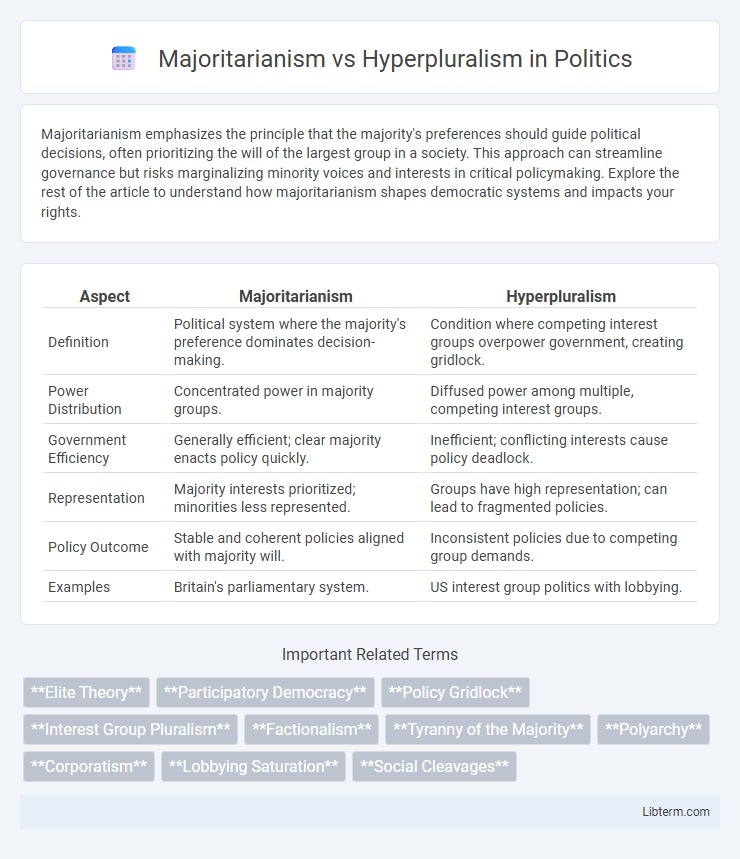Majoritarianism emphasizes the principle that the majority's preferences should guide political decisions, often prioritizing the will of the largest group in a society. This approach can streamline governance but risks marginalizing minority voices and interests in critical policymaking. Explore the rest of the article to understand how majoritarianism shapes democratic systems and impacts your rights.
Table of Comparison
| Aspect | Majoritarianism | Hyperpluralism |
|---|---|---|
| Definition | Political system where the majority's preference dominates decision-making. | Condition where competing interest groups overpower government, creating gridlock. |
| Power Distribution | Concentrated power in majority groups. | Diffused power among multiple, competing interest groups. |
| Government Efficiency | Generally efficient; clear majority enacts policy quickly. | Inefficient; conflicting interests cause policy deadlock. |
| Representation | Majority interests prioritized; minorities less represented. | Groups have high representation; can lead to fragmented policies. |
| Policy Outcome | Stable and coherent policies aligned with majority will. | Inconsistent policies due to competing group demands. |
| Examples | Britain's parliamentary system. | US interest group politics with lobbying. |
Understanding Majoritarianism: Definition and Principles
Majoritarianism is a political theory emphasizing that the majority's preferences should guide government decisions, ensuring that the most popular policies represent the collective will of the population. It operates on principles such as majority rule, equal participation, and the protection of the democratic process by allowing the majority to hold decisive power. This approach contrasts with hyperpluralism by prioritizing clear, majority-based outcomes over the competing interests of multiple, diverse groups.
Defining Hyperpluralism in Modern Politics
Hyperpluralism in modern politics describes a state where numerous interest groups aggressively compete for influence, resulting in policy gridlock and governmental inefficiency. Unlike majoritarianism, which emphasizes majority rule and unified policy direction, hyperpluralism highlights the challenges posed by fragmented political power and conflicting group demands. This phenomenon often leads to diluted decision-making and weakened government authority, complicating the implementation of coherent public policies.
Historical Origins of Majoritarianism and Hyperpluralism
Majoritarianism traces its historical roots to classical liberal democracy and the development of representative government in 18th-century Europe, emphasizing majority rule as a foundation for legitimate political authority. Hyperpluralism emerged in the 20th century as a response to the increasing complexity and fragmentation of interest groups in modern democratic societies, highlighting the challenges of governance amid competing factions. Key political theorists and historical events, such as the Federalist Papers and the rise of modern lobbying, illustrate the evolution from simple majority rule to the recognition of pluralistic influences in policymaking.
Key Differences Between Majoritarianism and Hyperpluralism
Majoritarianism emphasizes decision-making by the majority, where policies reflect the preferences of the largest group, ensuring clear and efficient governance often through majority rule in elections or legislative bodies. Hyperpluralism occurs when multiple competing interest groups with conflicting demands prevent coherent policy-making, leading to gridlock or fragmented government actions, reflecting the excessive influence of diverse groups. The key difference lies in majoritarianism's focus on majority rule and unified policy outcomes, while hyperpluralism highlights the complexity and paralysis resulting from competing group interests.
Strengths and Weaknesses of Majoritarianism
Majoritarianism promotes clear policy mandates by reflecting the preferences of the majority, ensuring government accountability and stability through decisive electoral outcomes. Its strength lies in simplifying decision-making and upholding democratic legitimacy, but it risks marginalizing minority groups and fostering exclusionary practices. The weakness of majoritarianism often results in the tyranny of the majority, where minority rights and interests are overlooked, potentially undermining social cohesion and pluralistic values.
Strengths and Challenges of Hyperpluralism
Hyperpluralism strengthens democracy by ensuring diverse interest groups have a voice, preventing any single faction from dominating the political landscape. It fosters a more inclusive policy-making process, reflecting a wide array of societal needs and preferences. However, hyperpluralism can lead to policy gridlock, as competing groups often block each other's initiatives, resulting in inefficient governance and slowed decision-making.
Majoritarianism in Practice: Examples and Impacts
Majoritarianism in practice emphasizes rule by the majority, evident in electoral systems like the United Kingdom's first-past-the-post, where the candidate with the most votes wins, often leading to single-party majority governments. This approach streamlines decision-making and fosters political stability but may marginalize minority groups and suppress diverse viewpoints. The impact of majoritarianism manifests in policies that reflect the preferences of the largest voter bloc, occasionally resulting in polarized societies and reduced political pluralism.
Hyperpluralism in Action: Real-World Illustrations
Hyperpluralism manifests when diverse interest groups create gridlock in policymaking, exemplified by the U.S. government shutdowns caused by conflicting lobbyist pressures. The complex interplay of numerous factions in hyperpluralism leads to diluted policy outcomes and governmental inefficiency. Contrastingly, majoritarianism emphasizes majority rule, often streamlining decision-making but risking minority interests.
Effects on Policy-Making and Governance
Majoritarianism centralizes decision-making authority, enabling swift policy implementation that reflects the preferences of the majority, but often marginalizes minority interests and reduces comprehensive deliberation. Hyperpluralism disperses power across numerous competing interest groups, leading to policy gridlock and fragmented governance as conflicting demands stall decisive action. This fragmentation often results in diluted policies intended to appease diverse factions, undermining effective government responsiveness and coherence.
Choosing Between Majoritarianism and Hyperpluralism: Implications for Democracy
Choosing between majoritarianism and hyperpluralism significantly impacts democratic governance, as majoritarianism emphasizes majority rule, ensuring clear policy direction but potentially marginalizing minority groups. Hyperpluralism promotes extensive interest group participation, fostering diverse representation but often causing legislative gridlock and policy inconsistency. Balancing these models requires addressing the trade-offs between effective decision-making and inclusive representation to strengthen democratic legitimacy and responsiveness.
Majoritarianism Infographic

 libterm.com
libterm.com